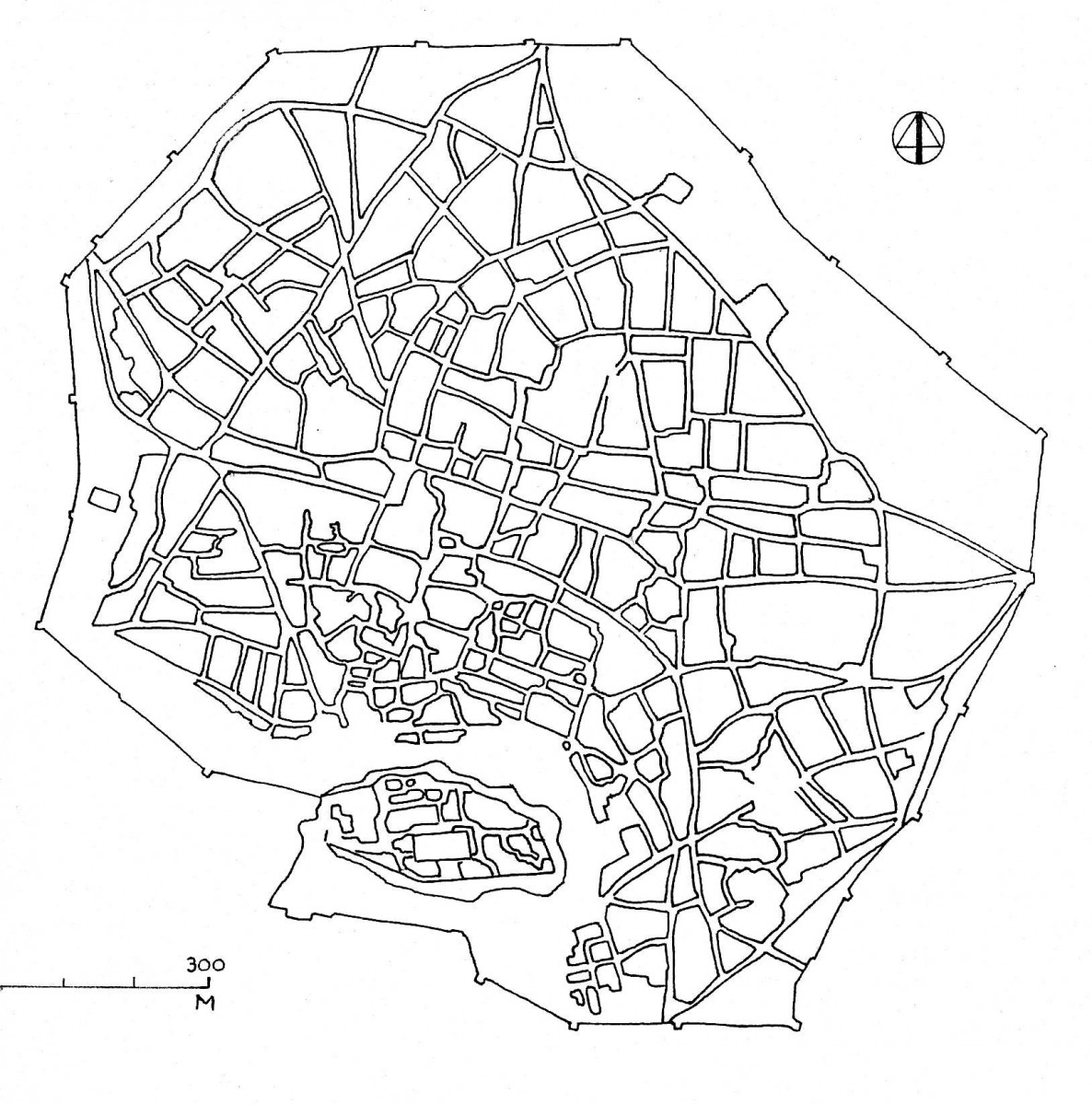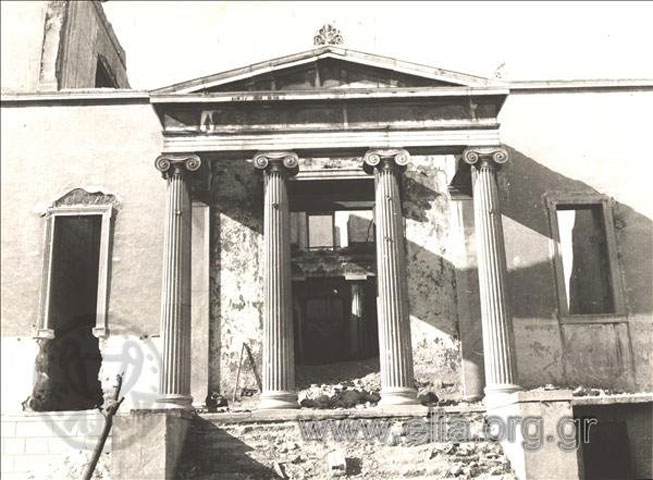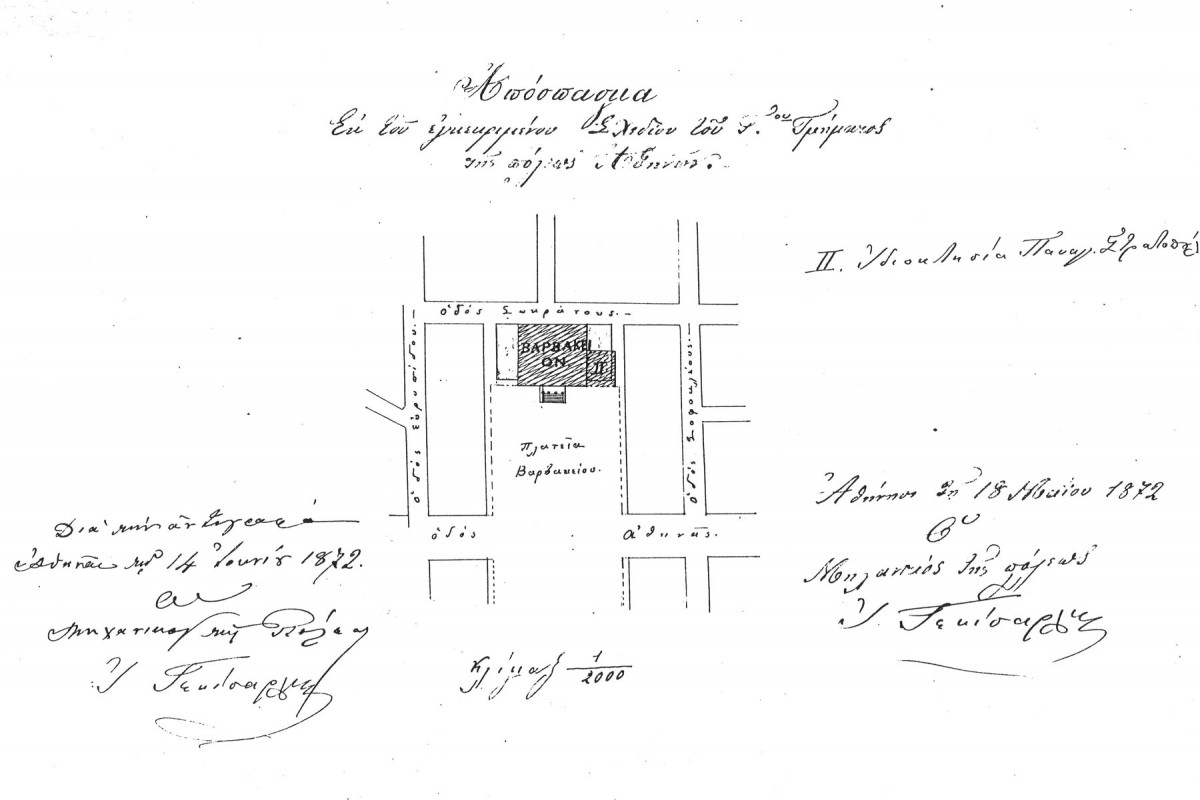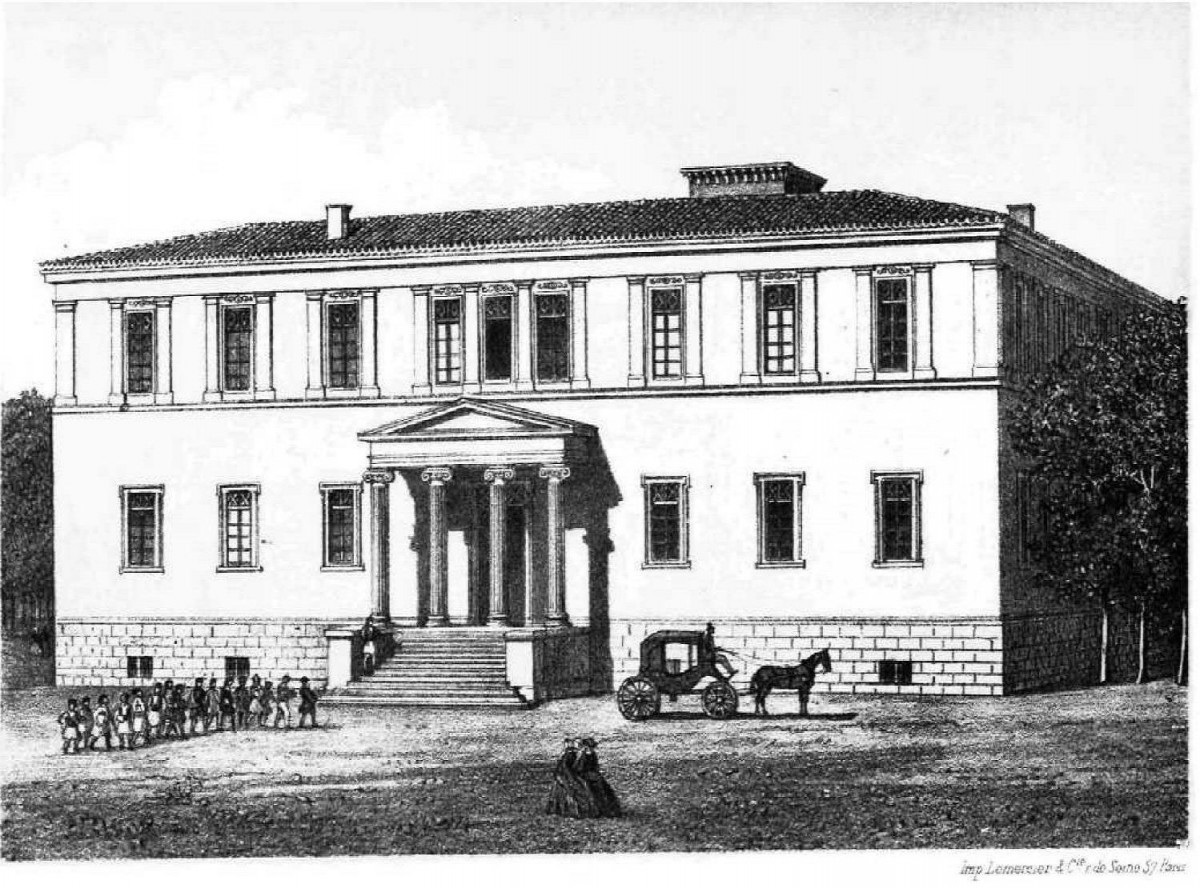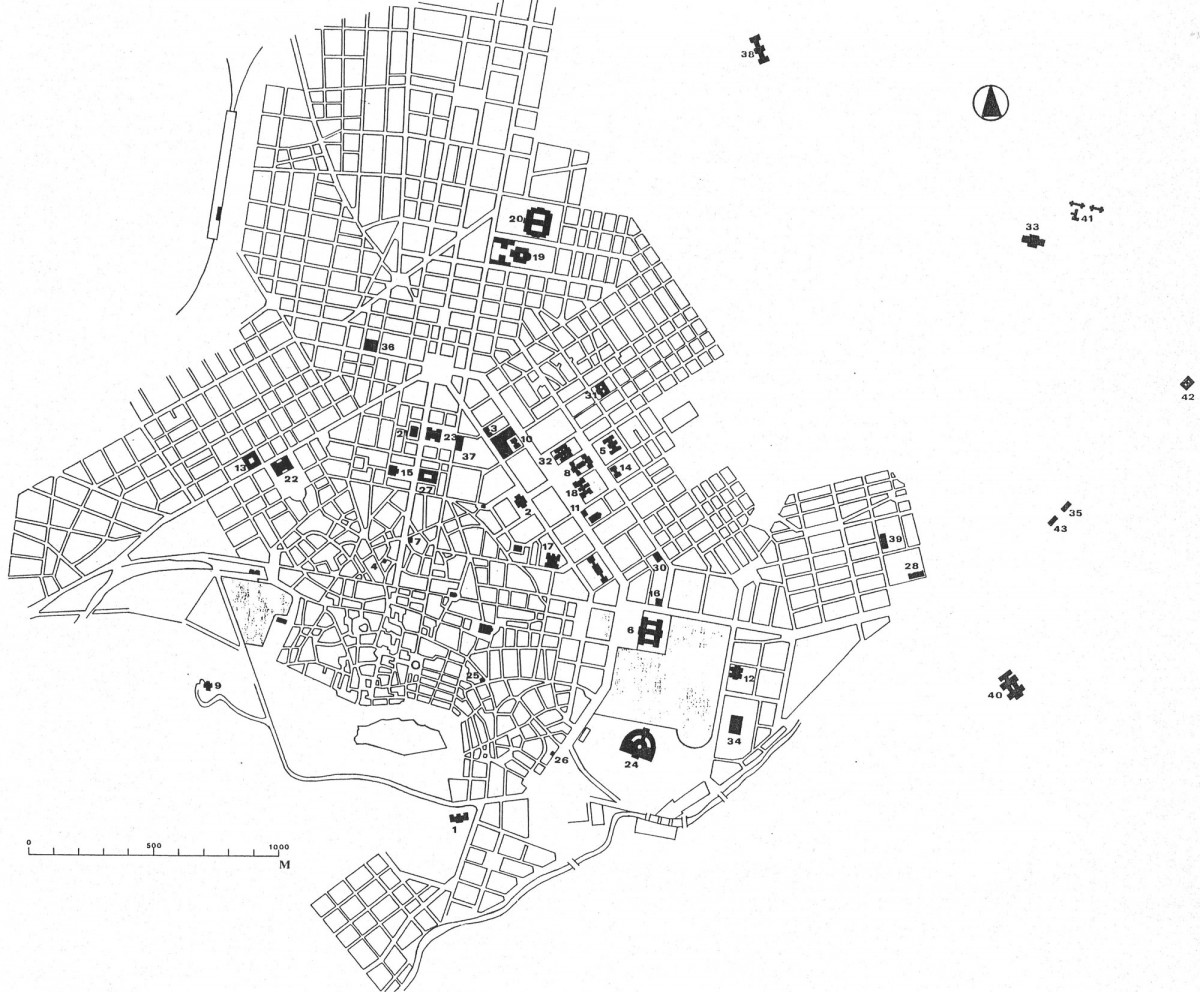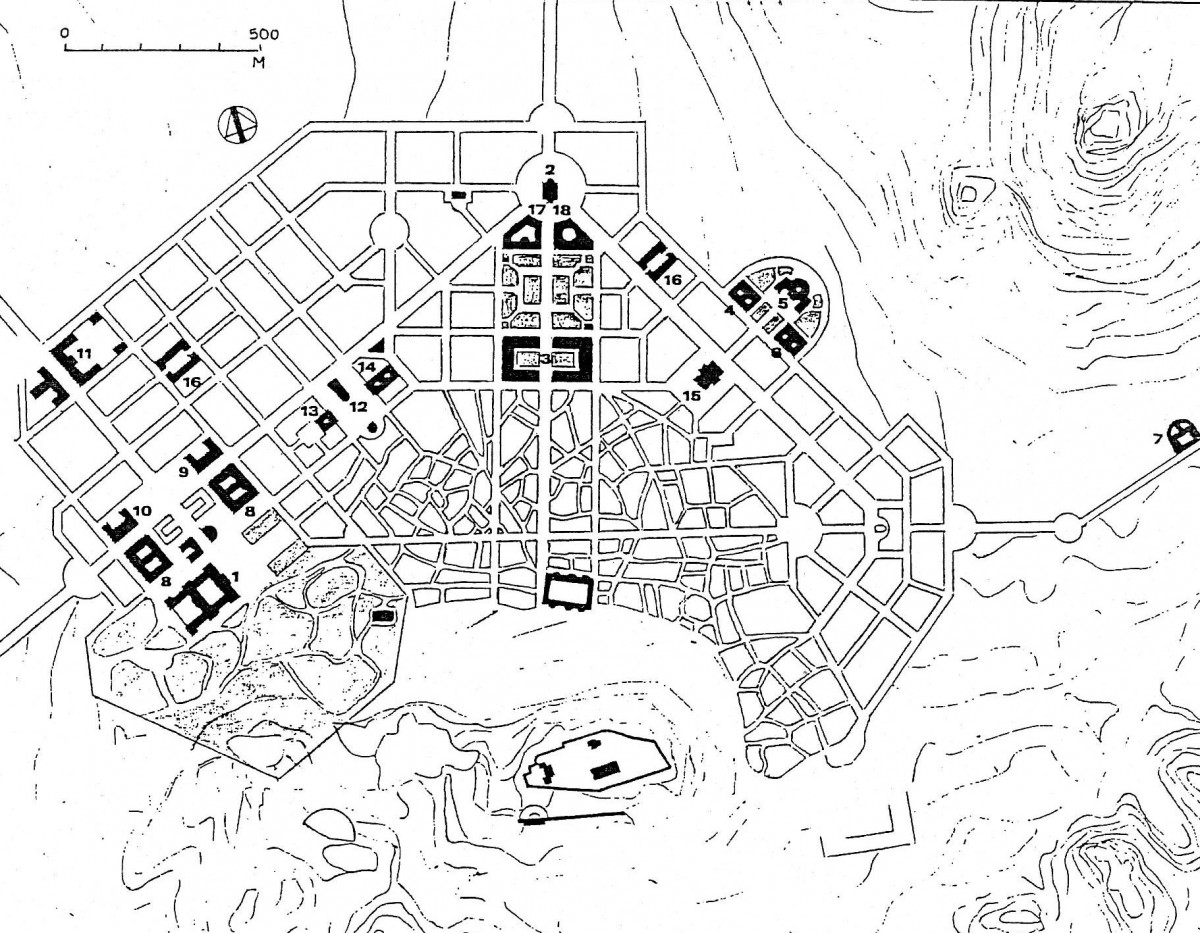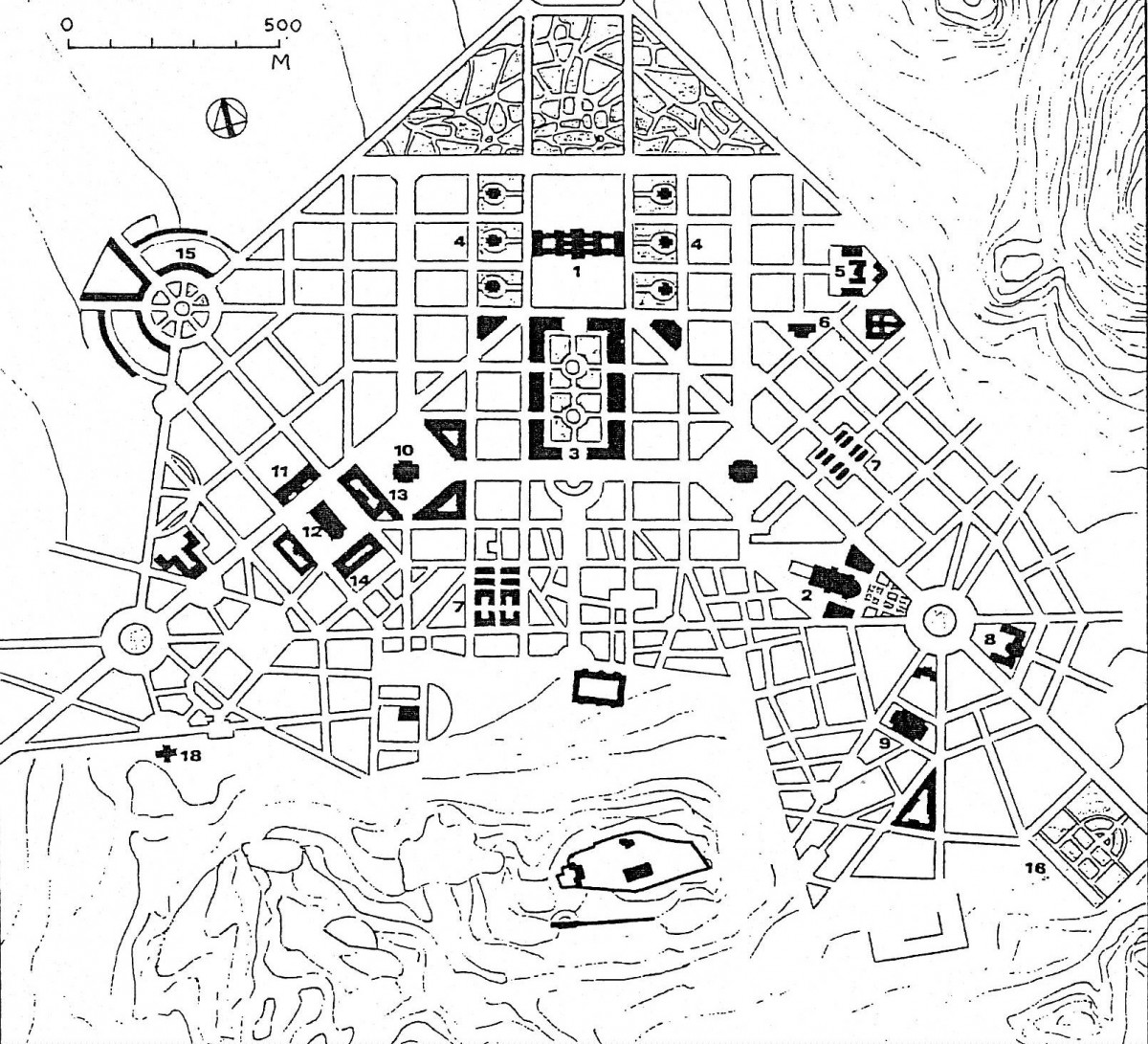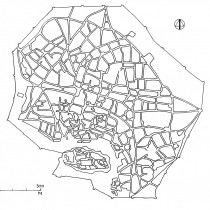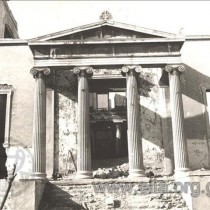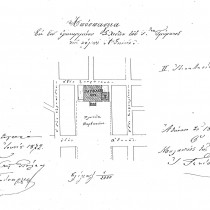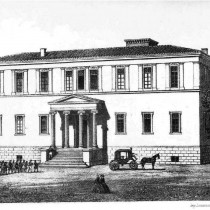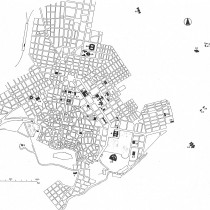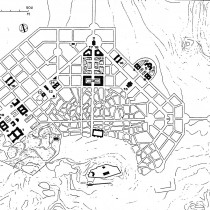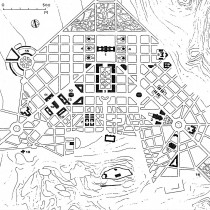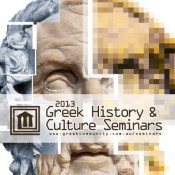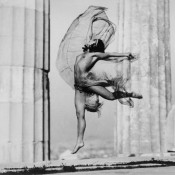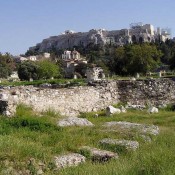The building of the Varvakeion Lyceum, later known as the Varvakeios Model School, is a typical example of the role played by emblematic educational buildings in 19th century Athens. Varvakeion has an important place among public buildings of Athens, constantly appearing in various state documents and the writings of architects who refer to issues regarding the location of these buildings and their overall relation to the city. The present article examines the reasons for this interest.
After the founding of the new Greek State in 1830, the Greek authorities tried to turn Athens, the kingdom’s capital, into a European city, replacing the existing prerevolutionary settlement that could not satisfy western European principles of the period on urban planning and architectural design (fig. 1). The city’s new plan would be a modern “response” to the medieval urban fabric which was the result of free “organic” development. Public architecture would be of essential in fulfilling this purpose; all official buildings would be exclusively located in a district of the new city, allowing them to be surrounded by the necessary public space. The latter would also follow west European standards in terms of size and layout, which had not happened in Ottoman Athens.
Understanding the plans for the new city of Athens and the role of public buildings in them requires an understanding of the position then held in the world by Athens. Ideologically speaking, this position was the most prominent among all cities of the Greek world. Following the rekindling of European interest in Greek antiquities that lead to the movement of classicism (note 1), due to the superiority of its ancient monuments, Athens became, to lovers of antiquity, the incarnation of the ancient world (note 2), which naturally played a decisive part in its being selected as capital city (note 3). Moreover, the choice as king of Greece of Otto, son of Ludwig I of Bavaria, perhaps the greatest lover of antiquity among all the then crowned heads of Europe, reinforced the ideological framework for creating the new capital.
The choice of Athens as capital was based on the desire to create ideological unity in the new kingdom and explains why Athens was singled out from other more suitable cities. The desired ideological unity had to satisfy both the demand that Greece be re united with its ancient past and that it join the civilized nations of Europe. That meant that Greece had to erase every trace of its Ottoman past and recreate itself based on its ancient heritage. Naturally, therefore, the most suitable city for this was Athens, where the presence of the ancient past was more powerful than anywhere else (note 4).
Institutions would have been a key factor in the Europeanization of the newly formed state, based of course on the respective states in Western Europe Therefore, the most suitable representatives of these institutions and consequently proof of Greece acquiring a more European character, would have been the buildings that housed them. This explains the particular importance acquired by the public buildings and their decisive role in shaping the Greek capital. Nevertheless, it should be noted that, unlike other European cities, in Athens interest centred not on administrative buildings, the symbols of power, but on buildings housing intellectual institutions, especially those related to education, referring to famous intellectual institutions of antiquity. Regenerated Greece was expected to take on both the cultural renaissance of all its historical region- still Ottoman territory for the most part – and the rebirth of its ancient glory in the field of culture (note 5). For this reason, educational buildings became objects of greater attention and grander than their administrative counterparts.
While the ideological framework explains the intensions in creating Neoclassical Athens, the economic realities of the newly formed state explain the conditions under which the capital’s public buildings were finally built. The poorest provinces of Hellenism were part of the kingdom of Greece, while the big urban centres had remained outside its borders (note 6). Hellenism did not owe its prominent place both in the economic life of the Balkans and the Middle East to the population of the small Greek kingdom, but to the Greeks of the Ottoman Empire, Ionian Islands (note 7) and European cities (note 8).
Despite, however, being economically insignificant throughout all the 19th century, the Greek state had undertaken projects that were beyond its means (note 9) because of its inversely proportionate ideological position in the Greek world. Even the partial realization of these projects was made possible almost entirely through donations of wealthy Greeks of the Diaspora who, for reasons explained above, focused mainly on cultural institutions.
Donations are a key economic factor in the founding of public buildings in Athens through the whole of the 19th century and beyond, originating almost entirely from rich Greek bourgeois living abroad. The lack of great fortunes in the Greek kingdom was due not only to the poverty of these regions, but also to the fact that the rich inhabitants of the districts that had rebelled, had spent or lost entire fortunes in the Revolution (note 10). Thus, only the Greeks of the Diaspora could make available the huge sums required. The importance of these donations and their decisive contribution in realizing the grandiose plans regarding the public buildings of the Greek capital becomes apparent when comparing amounts offered by the public revenue or state budget (note 11). The donations alone, all made prior to 1870, by Kritski, Dompoli, Vernardakis, Varvakis, Rizaris, Vallianos Chloros, Sinas, Tositsas and Papadakis, in total representing a sum of 25,000 000 drs, exceed the entire budget of the Ministry of Education, responsible for the institutions being financed, in the period following Independence up to that year (note 12).
It is obvious from the above that the buildings of the cultural institutions of Athens, monumental by Greek standards, could never have been realized in their final form, if not for those exceedingly rich Greeks who offered considerable amounts from their enormous fortunes towards realizing the symbols of their country’s rebirth. This is also apparent when comparing those buildings built through the generosity of these benefactors with others funded mainly from state or municipal resources, or from much smaller local donations. The following buildings belong to the first category: the University, Academy, National Library, Observatory, Technical University, Arsakeion School, Varvakeion Lyceum, Archaeological Museum, Zappeion, Stadium, both the Municipal and Royal Theatre, Marasleio School and most hospitals from the period of King George I of Greece.The second category includes the Palace, Military and Civil Hospitals, Criminal Court, National Printing House, Mint, Eye Hospital, Parliament, City Hall, Municipal Infants’ Hospital, Military Court and Military Academy. The general rule is that public buildings generously funded by rich Greeks abroad very often rivalled respective buildings in big capitals of Europe , while the rest very clearly reflected the poverty of the Greek state of the time, particularly the first buildings of the Ottonian period (note 13).
The Greek state’s inability to fund public buildings is also apparent in its efforts for construction cost not to exceed donations. We have the relative decree “On constructing the Gymnasium (Lyceum) of I. Varvakis” where it is stated that the plan must be made “within the not to be exceeded budget of one hundred and eighty thousand drachmas to be spent on the building, plot of land and interior decoration” (note 14). [None the less, the building’s total cost came to 440,500 drachmas (note 15)].
Numbers show that the remaining public buildings could be constructed at a much smaller cost than that permitted by the various donations. Besides, if the public buildings were made more economically, they would have a shorter building period, unlike that of the “beneficial” buildings that was spectacularly longer, while the amounts of money saved could be used to construct other buildings that were outstanding, certainly in a less extravagant way.
This, however, would not be compatible with the benefactors’ desire to offer Athens buildings worthy both of Hellenism’s splendid past and expectations for its revival. Thus, the benefactors’ preferences, combined with the financial potential of the Greek state rather than occasionally expressed priorities, defined, in the long run, the type and form of public buildings erected in Athens.
The plans for the new city of Athens, both the original one by Stamatis Kleanthis and Eduard Schaubert (fig. 2) as well as the one modified by Leo von Klenze (fig. 3) make it clear that there was a desire to create a new European capital, extending beyond the urban web from the time of Turkish rule, even placing all the public buildings in the new city. This was to have the form of a triangle with Ermou street as its base, Stadiou and Piraeus streets as its sides and bisected by Athenas street, while being connected with the old town by its key road axes penetrating the latter. Reality, however, was very different. Information of the era shows us there was a profound scepticism as to the possibilities and prospects for the city’s future expansion. At the time, nobody believed that Athens would ever reach such figures as those predicted in the plans of Kleanthis and Schaubert (not even other architects such as von Klenze and Lysandros Kaftantzoglou). These figures in terms of population had already been exceeded before the end of king Otto’s reign and regarding the area of the approved plan ,were delayed considerably, but all the same had been exceeded before the end of the century , while in regards to just the built up area were surpassed quite earlier on (fig. 4).
As a result we also have examples of plans for new public buildings being built in the heart of the old city, with a clear preference, however, for the three new streets of Ermou, Athenas and Aiolou (note 16), opened in the old part of town, to connect it with the new: In fact their intersection formed the heart of Athens all through the Ottonian period. The Varvakeion Lyceum was situated in the very hub of the city, in Athenas street and actually at the spot where the new part of town joins with the old. The reason for choosing this place is explained in the report made by the Minister of Education to king Otto regarding the location of Varvakeion (note 17), which refers to the suggested site (ultimately chosen)
“behind the Philadelphia towards the theatre” (note 18) that “it appears to be more central than most quarters of Athens compared with the site near the University that has already been proposed”. The minister also mentions that “a site was found behind the Philadelphia and in the direction of the theatre, which has been considered as the most appropriate, given its pleasant, healthy, central location” (note 19). It is worth noting that the initial choice was next to the University, the country’s leading cultural institution
The reason for the change is explained in the same report which records an excerpt from the report made by the committee regarding the building of Varvakeion, submitted to the Ministry on the 31st March 1851, according to which the committee “noticing (…) the place that had always been located between the University and the Eye Hospital (…) found it totally inappropriate because it would not be worthwhile to erect two large educational establishments close to one another (…)” and further believes that it is “not at all in the interest of the education of the young for them to continuously mix with University students” and that “noise and disorder can be prevented, resulting from the influx of crowds of pupils” (note 20). Of course, the final location of Varvakeion next to the Municipal market place far from fulfilled the committee’s original intentions.
The land that was publically owned also played a decisive part in the location of Varvakeion as with many other public buildings. Use of privately owned land was discouraged so as to avoid any complications resulting from this. The few buildings the government was obliged to build immediately after its arrival in Athens had to be realized in “any” location (note 21) there were plots of land either owned by the nation or to be purchased at the lowest possible price. This was also expressed officially by a decree stipulating that “Above all, plots must be selected from land belonging to the public” (note 22). The report mentioned above (note 23) by the Minister of Education to king Otto is characteristic in regards to the plot of land “behind the Philadelpheia” according to which “considering that the largest part of the plot belongs to the State, there will be a saving of several thousand drachmas that otherwise have been spent on buying private land”. This was followed by a relevant decree (note 24), in whichthescales were tippedinfavourof “the block situated on the southern side of the market place and owned largely by the public”. Since, moreover, the People’s Gardens, the biggest urban park in Athens, were to be located there (see figs. 2 and 3), the decree of June 12th 1844 was revoked “by which the block to the east of the University square was identified as the site of the said building” (note 25). One extreme case of saving money regarding the location of the Varvakeion is also the proposal for it to be on the island of Aegina because, among other reasons, of the existence there of the already abandoned Orphanage, thus helping restrict expenses to just the school’s equipment (note 26).
Finally, Varvakeion was built between 1857 and 1859, unusually quickly considering the building’s monumental scale, to plans by the architect Panagis Kalkos (fig. 5) who later designed the plans for the City Hall and the Archaeological Museum, establishing him as one of the most distinguished architects in 19th century Athens.
Following its construction, the Varvakeion building made its prominent position clearly felt in Athens of the period. In the proposal submitted by the Minister of the Interior to Otto regarding plots of lands necessary for the construction of public buildings, a catalogue of the buildings is presented with the site of many of them “according to the opinion of the Ministers in charge”. Among others, it is proposed that the Law courts be built “close to Varvakeion” (note 27). This earlier official reference to Varvakeion probably dates from the year it was completed, proving that it had already become a land mark, next to which it is proposed to build the Law courts, one of the most important public buildings in all European cities.
In the case of Athens, at least, if not in all European capitals, the development of the city was directly influenced by the location of its public buildings (note 28). Lysandros Kaftantzoglou writing about the excavation of the ancient city, says that “It should be forbidden once and for all, to carry out any plan for transforming and levelling in that direction, and particularly if public establishments are raised for reasons of embellishment” (note 29). As an example he mentions “the then horrible location of Geranion, where two years ago ( author’s note: in 1856 ) plots were sold at one and a half drachmas per cubit ,and today, following the construction of the Varvakeion Lyceum and some other houses, the price rose to twelve drachmas and maybe, after the building has been completed, will reach fifteen drachmas” (note 30). The minister of Education apparently thought this to be expected, since in his relevant report to Otto he writes that “by the building of the Varvakeion in that place, life should soon be given also to that part of the city that till now seemed to have been abandoned” (note 31).
The monumental public buildings of the era significantly affect the formation of the urban fabric, which also indicates their prominent position. Among other things, they clearly influence the creation of the squares in Athens since, not surprisingly, efforts were not focused on creating squares as stipulated in the original plan, but in shaping those open spaces available around the sites finally selected for the construction of public buildings. It is worth noting that public buildings gave their names to many of the main streets and squares of the capital, at a time when these buildings certainly dominated all aspects of the city and determined the spot on which they stood. So there is a Varvakeion square (note 32) demonstrating that Varvakeion was seen in the public’s perception as one of the basic contributors to the capital’s physiognomy. Indeed, we notice that the order of the squares’ layout follows the order in which the public buildings are constructed. Thus in 1857, the following squares are paved; Constitution, Mint (today’s Klathmonos) Otto (today’s Omonoia) and Varvakeion (note 33) i.e. Varvakeion Square, all being among the first that were laid out in Athens, along with those that are still the most important today.
The Varvakeion plans have the general characteristics of most Neoclassical mansions in Athens; namely a closed shape that, unlike traditional architecture, does not take into account Greece’s climate, but copies the imported typology of classicism adapted to the climate of the countries where it was born. However, at least in the case of schools, refusal to adapt neoclassical styles to the country’s climate must be because their design faithfully follows corresponding German models, which must have been the authorities’ wish, since the whole organization of the Greek educational system was founded on these. Thus, based on the prevailing view, the appearance of the buildings would have to reflect the educational functions housed within.
Perhaps the severity of the Varvakeion architecture was directly influenced by the Palace, since Kalkos had worked there, assisting Riedel who had undertaken to oversee the building based on designs by Friedrich von Gärtner (note 34). Kalkos seems to have consciously adopted morphological elements of early German classicism: a symmetrical lay out of the space in the ground plan, a cuboid volume, the division of the facades into three parts horizontally, and a complete lack of ornamentation, either painted or sculpted. It is however worth noting the portico of the entrance. Varvakeion is one of the few public buildings that include a portico shaped like a temple, with full length columns bearing a complete entablature and pediment, while all of it projects from the building making it particularly monumental. This sort of arrangement is usually absent from most Greek neoclassical buildings for reasons of economy, since full length columns with the corresponding entablature cost much more than the jambs usually preferred. This is yet another indication that Varvakeion was an especially expensive construction by Greek standards of the time.
The importance of the Varvakeion building is also apparent from other public functions that it served. Shortly after its construction, we move on to the period of the long reign of George I. In the Greek capital, George found more needs for public buildings, as yet unfulfilled, many of which were satisfied by buildings with other objectives in mind. Varvakeion did not stray from the rule. Thus, when in 1863 the Archaeological Society was obliged to remove the antiquities from the arcades of the University’s inner courtyard, where they had been till then, it placed them in the courtyard of the Academy. In 1864, however, the University senate asked the Society to also abandon the anatomy amphitheatre, because the classrooms in the building were not sufficient for the students whose number was rapidly increasing (note 35). In 1865, the Society transferred all its collections to Varvakeion (note 36), but the cramped space soon became apparent there as well. Thus, the Society placed all its collections in the Thiseion, the Acropolis, near the Lodge for Retired Soldiers, in confined archaeological sites and in the courtyard of the Archaeological Museum, then under construction. At the end of 1874, the Society also transfers antiquities to the west wing of the Museum that had just been completed. At the beginning, however, of 1875, with the increase of Varvakeion pupils, the Society is obliged to leave first two classrooms and in 1880 the whole building, except for the basements where antiquities are still kept. Apart from the above, Varvakeion had also operated as a provisional hospital of the Greek Red Cross (note 37).
The importance of the Varvakeion is also apparent from its place in interventions within the urban fabric. Some of these were made so as to create axes of symmetry and optical relations. We are shown this in the decree stating that the street connecting Theatre square (Plateia Theatrou) with Socratous street be configured in such as way that “its axis passes through the buildings of Varvakeion and the Theatre” (note 38).
Moreover, in this era, attempts are being made to create the necessary open space dictated on grounds both aesthetic and functional. During this period, the need to create open spaces and green areas in relation to public buildings was intensified, due to the prevalence of new views and standards of urban life that dictated the creation of open spaces for walking and recreation. These spaces, however, managed to be created mainly outside the city where plots of land were far cheaper. Thus, they could not usually be combined with public buildings which of course were situated in more central spots. We also have one example in the case of Varvakeion: The owner of a small house near this institution (fig. 6) suggests in a document that, following compensation, his property be granted to it, as it is useless to him (translator’s note: it was described as “ramshackle”), whereas it could be used by Varvakeion as a “courtyard gym” with the acquisition of a few more pieces of land (note 39). Moreover, as we are informed in a report by the city’s engineer to the Ministry of the Interior, a reform was made by which adjacent property was granted to Varvakeion to be used as the school garden (note 40).
Unfortunately, the monumental Varvakeion building was destroyed in the events of 1944 (fig. 7) and remained in ruins up to 1956 when it was demolished. Its transfer to Asklepiou street in the Neapolis quarter of Athens till 1983 and its final removal from the city centre to Pchychiko, put an end to its role as a landmark and to the symbolic position of school buildings in the centre of the Greek capital. (The Papadopoulos Lyceum on Academias street had already been closed for a long time and both the Arsakeion on Panepistimiou street and the Rizareios Ecclesiastical School on Vassilisis Sophias Avenue had long since been moved from the centre of Athens). All the above marked changing conditions and perhaps expressed the more general estrangement of educational institutions from life in the capital city.
Dionysios Roubien
Assistant Professor TEI of Western Greece, Dr of NTUA and restorer NTUA and CHEC Paris
Legends of Figures 2 and 3
Fig. 2: 1. Palace 2. Cathedral 3. Central Marketplace 4. Ministries 5. Guard Building 6. Mint. 7. Market place 8. Αcademy 9. Library 10. Stock Exchange 11. Parliament 12. Church 13. Post Office 14. Headquarters 15. Olive press 16. ΒotanicalGarden 17. ExhibitionHall 18. Observatory.
Fig. 3: 1. Palace 2. Cathedral 3. Central Marketplace 4. Academy 5. Library 6. University 7. Exhibition Hall 8. Ministries 9. Senate 10. Parliament 11. Barracks 12. Church 13. Post Office 14. Prison and Police 15. Theatre 16. Markets 17. Diocese 18. Schools.
Fig. 4: 1. MilitaryHospital 2. Mint 3. Royal Printing press 4. Criminal court 5. Civic Hospital 6. Palace 7. 1st Primary School (Karamanou School) 8. University 9. Observatory 10. Arsakeion 11. Eye Hospital 12. Amaleion Orphanage 13. Hatzikonsta Orphanage (first building) 14. Papadopoulou Lyceum 15. Varvakeion 16. Military Pharmaceutical store 17. Parliament 18. Αcademy 19. Technical University. 20. Αrchaeological Museum 21. CityHall 22. MunicipalInfants’ Hospital 23. Municipal Theatre 24. Ζappeion 25. 2nd Primary School for Boys 26. Schools of “Ladies’ Association for the Education of Women” 27. Municipal Market place 28. Evangelismos Hospital 29.Syngrou Prisons 30. Military Court 31. Chemistry Laboratory 32. National Library 33. Epheveion of Averof 34. Palace of Crown Prince 35. Aretaion Hospital 36. Theatre Royal 37. National Bank 38. Military Academy 39. Marasleion School 40. Syngrou Hospital 41. Municipal Hospital 42. Commercial School (today’s Hippokrateion Hospital) 43. Eginiteion Hospital
